The compact SUV segment has become increasingly competitive, with brands like Audi and BMW stepping up their game. In this article, we will compare the Audi Q2 and the BMW 1er Reihe, focusing on their technical aspects, innovations, and overall performance. Let's dive into this intriguing battle of the compact titans.
Audi Q2 vs BMW 1 Series – Performance, range & efficiency compared
Compare performance, boot capacity, efficiency and price at a glance.
Find out which car is the better choice for you – Audi Q2 or BMW 1 Series?
Design and Body Type: Aesthetics Matter
When it comes to aesthetics, both the Audi Q2 and BMW 1er Reihe present strikingly different designs. The Audi Q2, with its robust SUV body type, portrays a powerful presence on the road. Standing at 1508 mm in height and 1794 mm in width, the Q2 emphasizes a sense of ruggedness, while also offering a spacious interior with a trunk capacity of 405 liters.
On the other hand, the BMW 1er Reihe showcases its sleek hatchback design that appeals to those who prefer a sportier look. Slightly longer at 4361 mm and wider at 1800 mm, its lower profile at 1459 mm exudes a more athletic stance. The 1er Reihe provides a practical trunk capacity of 380 liters, making it an excellent contender for urban lifestyles.
Performance and Engine Options: Power Meets Efficiency
Under the hood, Audi offers the Q2 with a versatile range of petrol and diesel engines, producing power outputs ranging from 116 HP to a thrilling 300 HP. The Q2’s acceleration capabilities also impress, with top models reaching 0-100 km/h in just 4.9 seconds. The model year 2024 includes both manual and dual-clutch automatic transmission options, giving drivers flexibility based on their preferences.
Meanwhile, the BMW 1er Reihe features a range of options, including petrol, diesel, and mild-hybrid offerings, which allow for improved fuel efficiency while still delivering respectable power outputs, up to 300 HP. With accelerations as quick as 4.9 seconds, it matches the Q2's performance, while the top speed can reach 250 km/h. Both brands offer front-wheel drive and all-wheel drive configurations, allowing for enhanced traction and control.
Fuel Efficiency: Keeping the Environment in Mind
Fuel efficiency is a significant consideration nowadays, and here the rivalry gets even more interesting. The Audi Q2 showcases consumption rates ranging from 4.8 to 8.4 L/100km, depending on the chosen engine. Its CO2 emissions vary from 127 g/km to 190 g/km, some being within the CO2 efficiency classes D to F.
On the flip side, the BMW 1er Reihe has an edge in terms of fuel efficiency, with figures as low as 4.3 L/100km and emissions from 112 g/km. Most models qualify in better efficiency classes, ranging from C to D, making them a more environmentally friendly choice in the compact segment.
Technology and Innovations: Driving the Future
In terms of technology, both the Audi Q2 and BMW 1er Reihe incorporate advanced systems that enhance driving experience. The Q2 arrives with Audi’s MMI infotainment system, offering seamless navigation and smartphone integration, along with the option for a virtual cockpit to deliver real-time driving information.
The 1er Reihe, on the other hand, comes equipped with BMW's iDrive system, which includes an intuitive interface for accessing media, navigation, and car settings. Both vehicles also support driver assistance technologies that provide advanced safety features, making them well-suited for modern drivers.
Conclusion: Which One Reigns Supreme?
Choosing between the Audi Q2 and the BMW 1er Reihe ultimately comes down to personal preference and intended use. The Q2 offers a robust SUV body, impressive power capabilities, and a more spacious interior, making it ideal for those who require versatility and space.
Conversely, the BMW 1er Reihe provides a sportier experience with enhanced fuel efficiency and advanced technological features catering to a performance-oriented driver. Each model has its unique merits, and potential buyers would greatly benefit from a test drive to determine which vehicle best suits their lifestyle.
Here’s where it gets real: The technical differences in detail
Costs and Efficiency:
When it comes to price and running costs, the biggest differences usually appear. This is often where you see which car fits your budget better in the long run.
Audi Q2 has a to a small extent advantage in terms of price – it starts at 24900 £, while the BMW 1 Series costs 28800 £. That’s a price difference of around 3943 £.
Fuel consumption also shows a difference: BMW 1 Series manages with 4.30 L and is therefore a bit more efficient than the Audi Q2 with 4.80 L. The difference is about 0.50 L per 100 km.
Engine and Performance:
Under the bonnet, it becomes clear which model is tuned for sportiness and which one takes the lead when you hit the accelerator.
Both models deliver identical power – 300 HP each.
Both models accelerate almost equally fast – 4.90 s from 0 to 100 km/h.
There’s no difference in top speed – both reach 250 km/h.
Both models offer the same torque – 400 Nm.
Space and Everyday Use:
Whether family car or daily driver – which one offers more room, flexibility and comfort?
Both vehicles offer seating for 5 people.
In curb weight, Audi Q2 is to a small extent lighter – 1330 kg compared to 1465 kg. The difference is around 135 kg.
In terms of boot space, the Audi Q2 offers slight more room – 405 L compared to 380 L. That’s a difference of about 25 L.
In maximum load capacity, the BMW 1 Series performs to a small extent better – up to 1200 L, which is about 150 L more than the Audi Q2.
Maximum payload is identical – both can carry up to 510 kg.
Who comes out on top?
Overall, the Audi Q2 shows itself to be edges out slightly and secures the title of DriveDuel Champion.
It convinces with the more balanced overall package and proves to be the more versatile choice for everyday use.
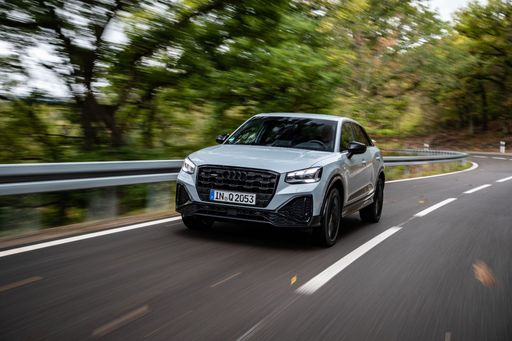 @ Audi AG
@ Audi AG
Audi Q2
Audi Q2
The Audi Q2 packs Audi’s premium attitude into a compact, cheeky package that turns city streets into a runway for tasteful design and clever practicality. It’s an easy car to live with thanks to an upscale cabin, composed manners and sprightly handling, and while it won’t satisfy someone chasing sports-car thrills, it’s a smart, stylish pick for buyers who want substance with a wink.
details @ Audi AG
@ Audi AG
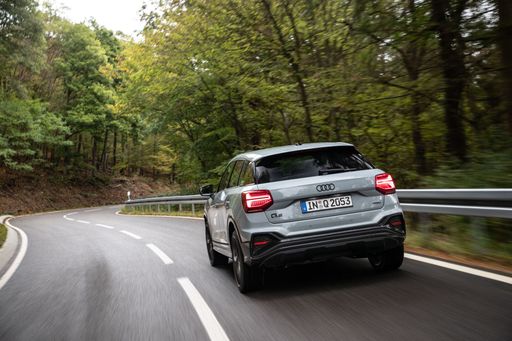 @ Audi AG
@ Audi AG
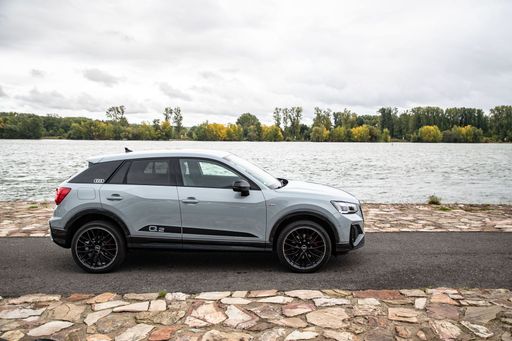 @ Audi AG
@ Audi AG
 @ Audi AG
@ Audi AG
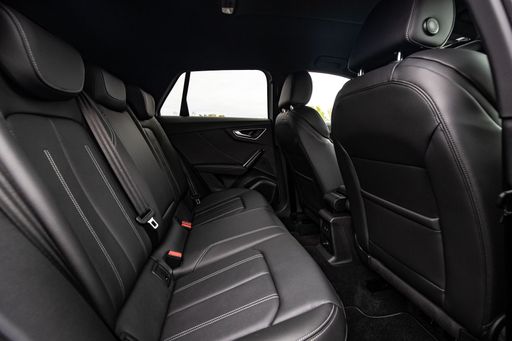 @ Audi AG
@ Audi AG
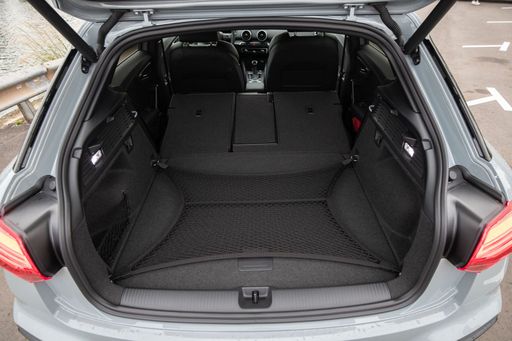 @ Audi AG
@ Audi AG
BMW 1 Series
The BMW 1 Series stands out with its dynamic design that embodies both elegance and sportiness, making it an attractive choice for urban driving. Its interior offers a premium feel, combining quality materials with the latest in technological features to enhance comfort and connect drivers. Under the bonnet, a range of efficient engines ensures a responsive and enjoyable driving experience, balancing power with practicality.
details @ BMW Group Press
@ BMW Group Press
 @ BMW Group Press
@ BMW Group Press
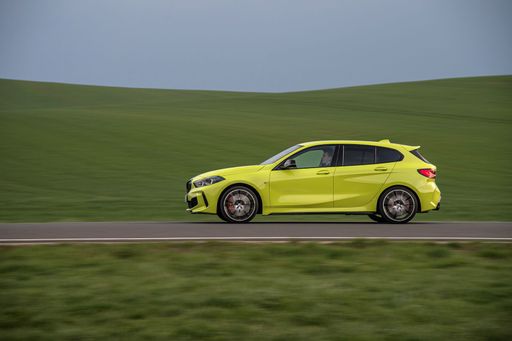 @ BMW Group Press
@ BMW Group Press
 @ BMW Group Press
@ BMW Group Press
 @ BMW Group Press
@ BMW Group Press
 @ Audi AG
@ Audi AG
|
 @ BMW Group Press
@ BMW Group Press
|
|
|
|
Costs and Consumption |
|
|---|---|
|
Price
24900 - 43600 £
|
Price
28800 - 51100 £
|
|
Consumption L/100km
4.8 - 8.1 L
|
Consumption L/100km
4.3 - 7.6 L
|
|
Consumption kWh/100km
-
|
Consumption kWh/100km
-
|
|
Electric Range
-
|
Electric Range
-
|
|
Battery Capacity
-
|
Battery Capacity
-
|
|
co2
127 - 183 g/km
|
co2
112 - 173 g/km
|
|
Fuel tank capacity
50 - 55 L
|
Fuel tank capacity
49 L
|
Dimensions and Body |
|
|---|---|
|
Body Type
SUV
|
Body Type
Hatchback
|
|
Seats
5
|
Seats
5
|
|
Doors
5
|
Doors
5
|
|
Curb weight
1330 - 1610 kg
|
Curb weight
1465 - 1625 kg
|
|
Trunk capacity
355 - 405 L
|
Trunk capacity
300 - 380 L
|
|
Length
4208 - 4216 mm
|
Length
4361 mm
|
|
Width
1794 - 1802 mm
|
Width
1800 mm
|
|
Height
1495 - 1508 mm
|
Height
1459 mm
|
|
Max trunk capacity
1000 - 1050 L
|
Max trunk capacity
1135 - 1200 L
|
|
Payload
450 - 510 kg
|
Payload
475 - 510 kg
|
Engine and Performance |
|
|---|---|
|
Engine Type
Petrol, Diesel
|
Engine Type
Diesel, Petrol MHEV, Diesel MHEV, Petrol
|
|
Transmission
Manuel, Automatic
|
Transmission
Automatic
|
|
Transmission Detail
Manual Gearbox, Dual-Clutch Automatic
|
Transmission Detail
Dual-Clutch Automatic
|
|
Drive Type
Front-Wheel Drive, All-Wheel Drive
|
Drive Type
Front-Wheel Drive, All-Wheel Drive
|
|
Power HP
116 - 300 HP
|
Power HP
122 - 300 HP
|
|
Acceleration 0-100km/h
4.9 - 10.5 s
|
Acceleration 0-100km/h
4.9 - 9.8 s
|
|
Max Speed
197 - 250 km/h
|
Max Speed
210 - 250 km/h
|
|
Torque
200 - 400 Nm
|
Torque
230 - 400 Nm
|
|
Number of Cylinders
3 - 4
|
Number of Cylinders
3 - 4
|
|
Power kW
85 - 221 kW
|
Power kW
90 - 221 kW
|
|
Engine capacity
999 - 1984 cm3
|
Engine capacity
1499 - 1998 cm3
|
General |
|
|---|---|
|
Model Year
2025
|
Model Year
2024
|
|
CO2 Efficiency Class
D, F, E, G
|
CO2 Efficiency Class
D, C, F
|
|
Brand
Audi
|
Brand
BMW
|
What drivetrain options does the Audi Q2 have?
The Audi Q2 is offered with Front-Wheel Drive or All-Wheel Drive.
The prices and data displayed are estimates based on German list prices and may vary by country. This information is not legally binding.
